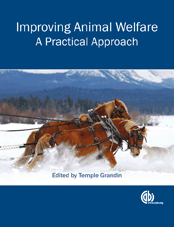 |
Improving Animal Welfare: A Practical Approach
Edited by Dr. Temple Grandin
Colorado State University, USA
ISBN: 978-1-84593-541-2
c. 336 pages
131 figures/illustrations
Subject Classifcation: KNAC, PSVP, TVH, TW
Territorial Market Rights: World
Published by CABI
Links for ordering:
- Amazon.Com
- CABI.org
|
Chapter 6: Painful husbandry procedures in livestock and poultry.
by Kevin J. Stafford and David J. Mellor, Massey University, New Zealand
There is increasing concern about the welfare of animals when painful procedures are performed such as castration, dehorning, beak trimming, branding, etc. The authors cover the latest research on the use of anesthetics and analgesics for pain relief. They also discuss the pros and cons of many procedures. The species covered are cattle, sheep, pigs, chickens, turkeys, and goats. There are 12 clear diagrams that show the correct procedures.
Below is an excerpt from Chapter 6...
Behavioral and physiological indicators of pain
Pain-inducing stimuli elicit a range of physiological and behavioral responses. They allow the presence or absence of significant pain to be assessed and strategies for alleviating the pain to be developed (Mellor et al., 2000). However, as pain is a subjective experience, which by definition is not quantifiable in absolute terms, all such variables are indirect indices of pain. Cautious interpretation is therefore required. Nevertheless, both physiological and behavioral indices have been used successfully in experimental settings to study animal pain responses. Physiological indices include changes in heart rate, blood pressure, rectal and skin temperatures, plasma levels of stress hormones and related metabolites, and brain electrical activity. Useful behaviors, which may be species-specific and/or injury-specific, enable acute, chronic and pathological pain to be distinguished, and they indicate when pain is present and, importantly, when it is at very low levels or absent. Some behavior is overt and obvious, such as the initial marked restlessness of lambs after application of rubber castration rings (Lester et al., 1996). Vocalization (bellows, moos or squeals) in cattle and pigs are associated with pain and distress during a procedure such as castration or branding. Cattle that were hot iron branded had more vocalizations compared to controls that were restrained and not branded (Lay et al., 1992a, b; Watts and Stookey, 1999). Vocalization (squeals) in piglets was reduced during castration when anesthetics were used (White et al., 1995). Less overt behavior such as the repetitive tail swishing in calves persists for about 8h after dehorning (Sylvester et al., 2004). Ear flicking after a procedure is another indicator of pain. Calves that had their tails docked had more ear twitching (Eicher and Dailey, 2002). In clinical settings, behavior, demeanor and appearance are used more commonly because they are more immediately observable than are some key physiological indices (Mellor et al., 2008). Changes in stress hormone concentrations or pain-related features of brain, electrical activity require subsequent biochemical or mathematical analysis.
See Chapter 1 for a table of behavioral indicator of pain after surgical procedures.
Grazing animals may hide pain
Older animals that are not completely tame, such as 4-6 month old extensively raised calves and sheep, may not exhibit obvious symptoms of pain after castration or dehorning. A common comment by ranchers is: ‘They must have little pain because my cattle ate and drank immediately after the operation.’ Grazing animals are prey species that often hide obvious pain behaviors to avoid being eaten by predators. This is most likely to occur in animals with a large flight zone that have some fear of people (T. Grandin, personal communication, 2008). Observation of 8-month-old bulls castrated with heavy rubber bands illustrates this problem (Grandin and Johnson, 2005). Some bulls acted normally, whereas others repeatedly stamped their feet and a few of them lay on the ground in strange contorted postures. These pain-related behaviors disappeared when a person walked up to their pen, and animals that were rolling on the ground jumped up and ran over to their herd mates when they saw a person. In order to see the pain-related behaviors, the observer had to be hidden so the animals did not know they were being observed. For all species, the most accurate way to study pain-related behavior after a procedure is to hide the observer or use a video camera. Sheep are the most defenseless prey species animal. They may be more likely to cover up and hide pain-related behavior especially when they see people watching.
 Click here to return to the Homepage for more information on animal behavior, welfare, and care.
Click here to return to the Homepage for more information on animal behavior, welfare, and care.
 Click here to return to Dr. Grandin's Books and Video page.
Click here to return to Dr. Grandin's Books and Video page.
 Click here to return to the Improving Animal Welfare Table of Contents page and read other chapter excerpts.
Click here to return to the Improving Animal Welfare Table of Contents page and read other chapter excerpts.


 Click here to return to the Homepage for more information on animal behavior, welfare, and care.
Click here to return to the Homepage for more information on animal behavior, welfare, and care.